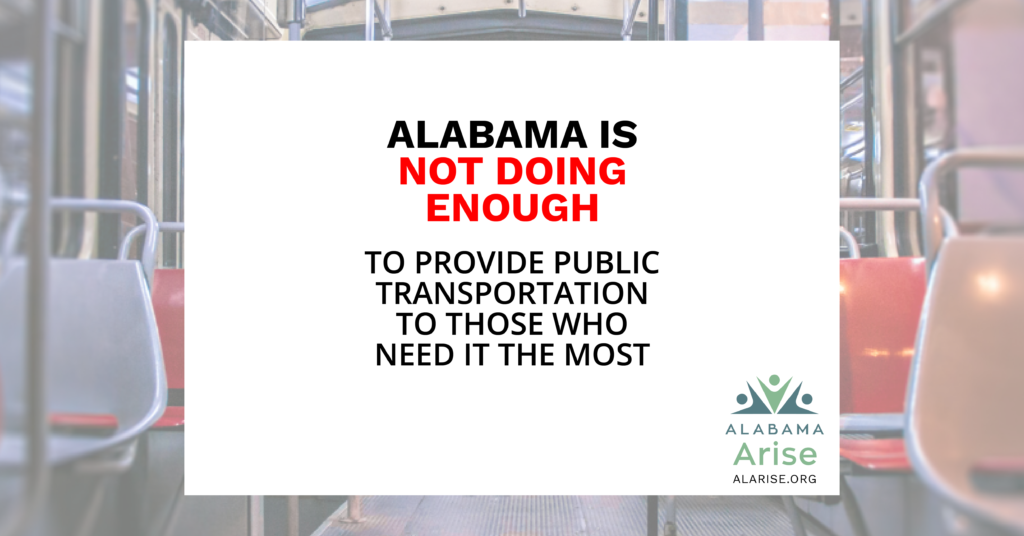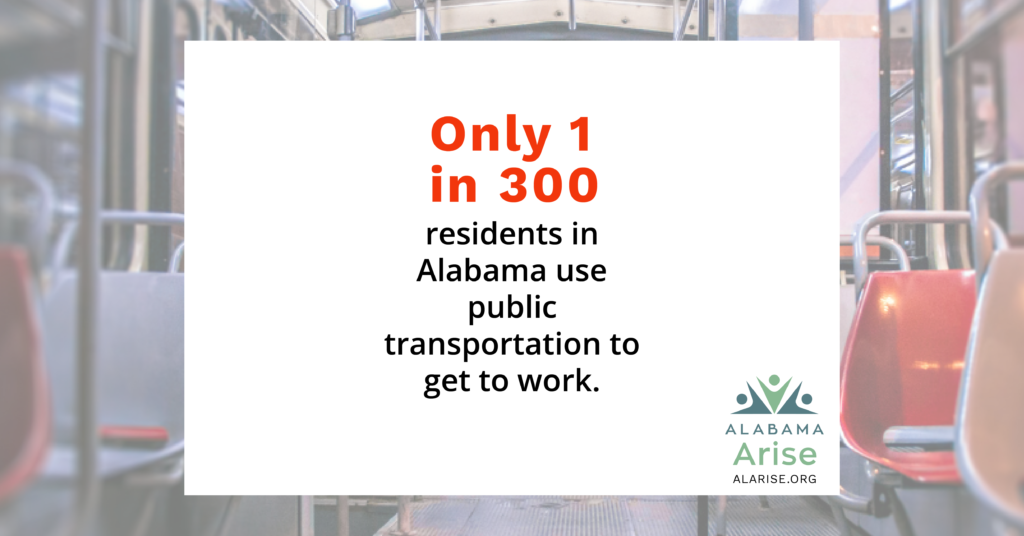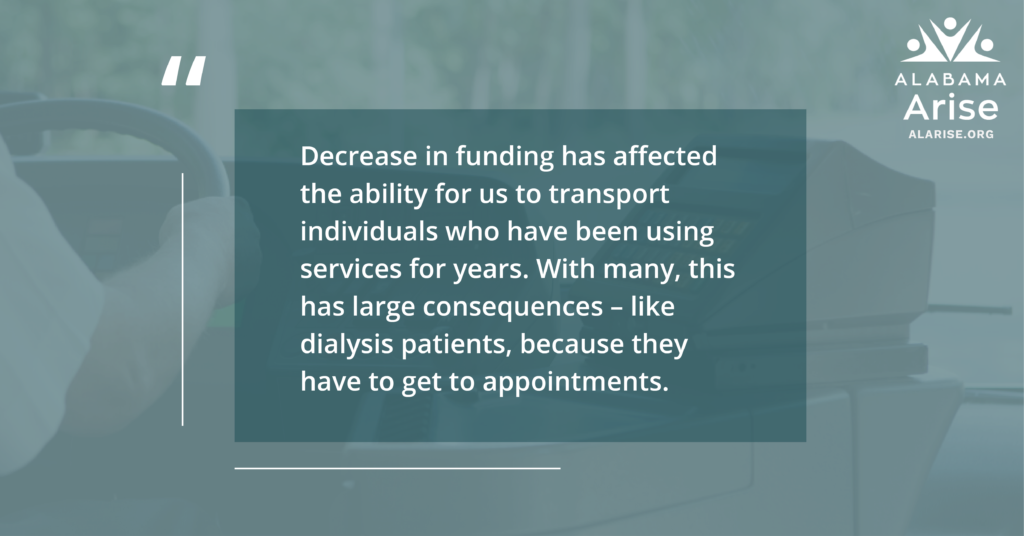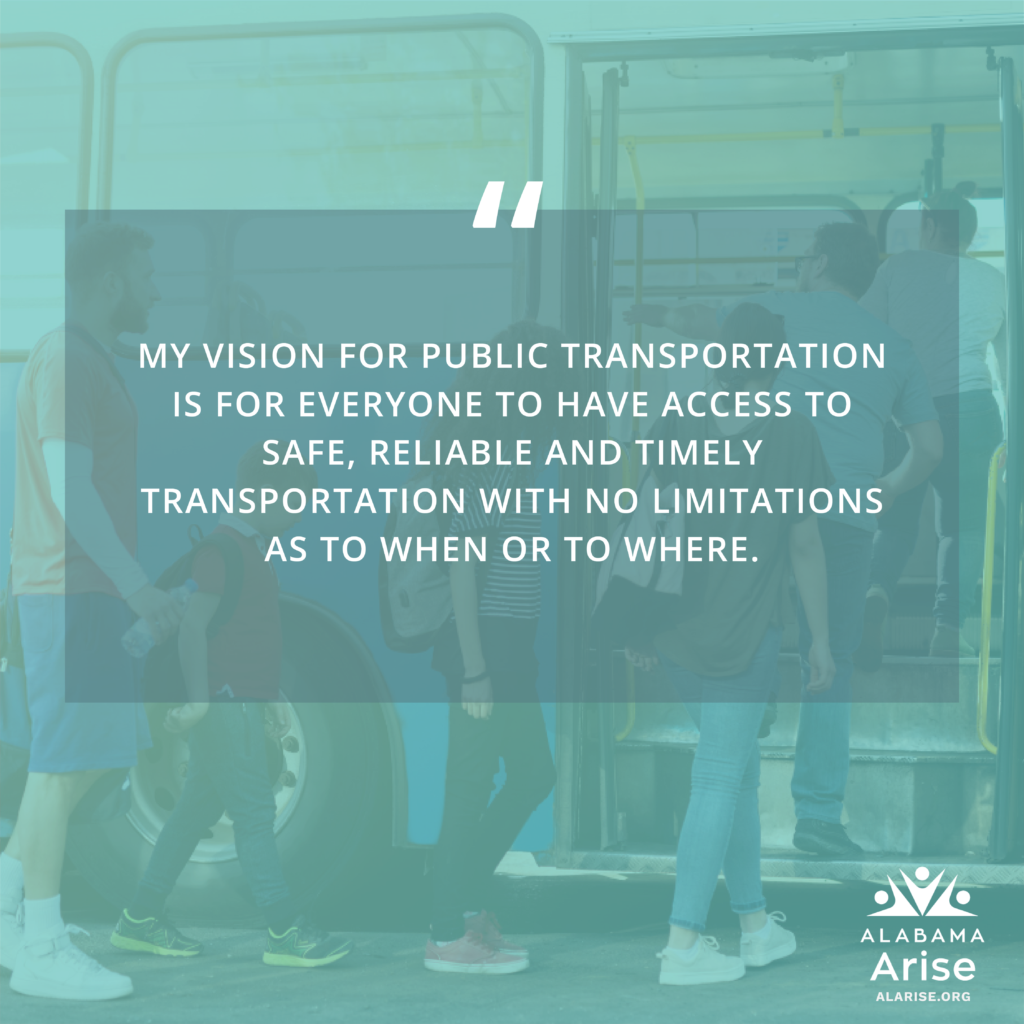Public transportation is an investment in people, communities, the economy and the environment. Many older adults, individuals with disabilities and people with low incomes need public transit to get to work, seek medical care, buy groceries and more.
By providing state funding for public transportation, Alabama lawmakers can help ensure these freedoms for everyone in our state. They could start by allocating $20 million of the state’s remaining American Rescue Plan Act (ARPA) money to the state Public Transportation Trust Fund.
The Alabama Legislature created the Public Transportation Trust Fund in 2018, but no state funds have been provided for it yet. As a result, the trust fund’s capacity to provide badly needed state matching funds for federal transportation dollars has languished. This inaction has left Alabama with a truncated and inadequate public transportation system.
Alabama Arise surveyed public transportation systems in 42 of our state’s 67 counties this spring to identify service barriers. The findings were clear: State funding and the resulting additional federal dollars would help lift many of these barriers. Alabama lawmakers should provide this crucial funding at the next available opportunity.
Public transportation is a critical unmet need for Alabama
“There is such a need [for public transportation], and people love it. Sometimes I ride and try to blend in so people don’t know who I am, and I hear people say how glad they are that the program came along. People are so grateful for the service.” – a south Alabama public transit director.
The Alabamians who use public transportation services the most are people with low incomes, older adults, people with disabilities, and people of color, according to the systems we surveyed. Alabama’s poverty rate is 16%. Of our state’s total population of slightly more than 5 million, 16.2% have a disability, 16.9% are over age 65 and 35.9% are people of color.
By contrast, only 0.3% of Alabama residents – or about one in 300 – use public transportation to get to work. And the average travel time to work in Alabama is about 25 minutes. A look at these numbers leads to a simple conclusion: Alabama is not doing enough to provide public transportation to those who need it the most.
State funding barriers undermine public transportation
“Maintaining vehicles with high mileage is hard, especially in rural counties. It might take 40 minutes to just go get someone.” – a south Alabama public transit director.
Public transportation systems require adequate and stable funding to operate. However, Alabama is one of only three states (along with Hawaii and Nevada) that provide no state money for public transportation. A 1952 constitutional amendment bars the Alabama Department of Transportation (ALDOT) from using revenue from the state gas tax or license fees for public transportation.
Nearly all money for public transportation in Alabama comes from federal dollars administered by ALDOT. Multiple federal COVID-19 recovery packages, including the Coronavirus Aid, Relief and Economic Security (CARES) Act and the American Rescue Plan Act (ARPA), temporarily provided additional money for many of Alabama’s public transportation systems. These funds will expire soon, but the need for public transportation services will remain.
Counties again will have to rely on the usual federal programs and grants along with local funds for public transportation. How these dollars are allocated and distributed to county transit authorities is a complicated process that makes it difficult to ensure they receive the funds their systems need.
Further, local transit systems must provide matching funds (state or local non-federal dollars) to receive federal transportation funds. Many counties receive matching funds from contracts with social services, other local organizations, county commissions, municipalities and other local sources.
Non-federal match requirements vary by program and can range from 10% to 50% of transit purchases or operations. Forty percent of surveyed systems said non-federal match is a problem for them or could be in the future.
Availability and access barriers are widespread
“Decrease in funding has affected the ability for us to transport individuals who have been using services for years. With many, this has large consequences – like dialysis patients, because they have to get to appointments.” – a central Alabama public transit director
Most Alabama counties only offer public transportation services Monday through Friday, our survey found. Counties with weekend services only provide transportation on Saturdays and on a limited basis, such as only in urban areas or with restricted hours. Most county systems are unable to provide weekend services due to lack of resources.
Many counties do not offer public transportation services after 4 p.m., and just as many do not begin providing transportation until 8 a.m. This scheduling creates a gap for people who need transportation to and from work for shifts ending after 4 p.m. or starting at or before 8 a.m. Almost no public transportation systems in Alabama provide services past 6 p.m., so night-shift workers are unable to get a ride to and from work.
Because of limited funding, some systems have had to curtail specialized services for riders with disabilities or serious health conditions. Some systems struggle to afford wheelchair-accessible equipment. One system reported it had to end several contracts with local organizations serving older adults or people with disabilities because it couldn’t afford to provide services. Other systems are often unable to offer more than basic wheelchair accessibility.
Systems said they struggle to find and keep bus drivers because they cannot pay competitive wages. For these systems, the lack of drivers means they cannot afford to run on any weekends or past 4 p.m., or they must limit the number of routes provided.
The need for technology upgrades
“We need to have more tech, take cards on the buses, get away from cash, GPS on the buses.” – a north Alabama public transit director
Ride scheduling processes for many public transportation systems are outdated and complicated. Most systems still use call-in systems where riders have to schedule a pickup at least 24 to 48 hours in advance.
More efficient options exist. In an effort to streamline services and increase accessibility, Baldwin County’s transit system uses a downloadable app to schedule rides. In February, the county reported 42% of users used the app rather than calling to make an appointment.
Alabama needs updated technology to operate its public transportation systems more effectively. But this technology costs money, and it will require state funding to pull down federal dollars for modern technology.
New technology also would help when it comes to rider fees. Many counties struggle with payment of bus fees, either because of exact cash payment requirements or residents’ inability to pay even minimal fees. Alternative payment methods (payment via website, app, card reader, etc.) would lessen the burden for riders and drivers. Again, this would require purchasing additional equipment.
A better, more connected future
“My vision for public transportation is for everyone to have access to safe, reliable and timely transportation with no limitations as to when or to where.” – a north Alabama public transit director
“What would be your vision for your system if you had the resources?” That was one of the final questions on our survey of county transit system directors. The responses painted a picture of an Alabama where everyone can get where they need to go. Many directors said they would expand services by hiring more drivers and buying more vehicles. Some said new funding would allow them to purchase new technology. And others highlighted their desire to extend riding days and times and expand their travel area.
Our state’s lack of state public transportation funding makes maintaining and using public transit incredibly difficult for people who use the systems. And it likely discourages many people from trying to use public transit at all.
Alabama deserves better. State lawmakers should invest $20 million from the remaining American Rescue Plan Act funds into Alabama’s Public Transportation Trust Fund. By doing so, our state can empower local transportation systems to provide the services that their riders need.
These investments in public transportation would expand economic opportunity and advance racial equity. And they would help build an Alabama where everyone can stay connected and reach their full potential.
About the authors
Elaine Burdeshaw was an intern at Alabama Arise in spring 2022. Turner Griffin was an intern at Arise in fall 2021 and spring 2022. They completed this report during their internships. Both received their Master of Social Work degrees from the University of Alabama in May 2022.
Last updated June 16, 2022.





